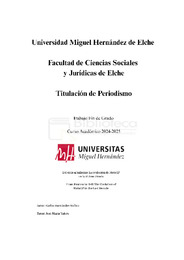Please use this identifier to cite or link to this item:
https://hdl.handle.net/11000/37487Full metadata record
| DC Field | Value | Language |
|---|---|---|
| dc.contributor.advisor | Valero Pastor, José María | - |
| dc.contributor.author | Hernández Molina, Carlos | - |
| dc.contributor.other | Departamentos de la UMH::Ciencias Sociales y Humanas | es_ES |
| dc.date.accessioned | 2025-09-24T07:25:02Z | - |
| dc.date.available | 2025-09-24T07:25:02Z | - |
| dc.date.created | 2025 | - |
| dc.identifier.uri | https://hdl.handle.net/11000/37487 | - |
| dc.description.abstract | Desde 2015, MotoGP ha vivido una transformación profunda que ha afectado tanto al espectáculo en pista como a su repercusión mediática. Tras una era dorada con figuras legendarias como Valentino Rossi o Jorge Lorenzo, la categoría reina del motociclismo ha visto cómo su popularidad se ha ido desinflando. La retirada de grandes ídolos ha dejado un vacío difícil de llenar, mientras que las nuevas generaciones aún no han logrado conectar con el gran público. A esto se suma un cambio en los hábitos de consumo: las audiencias tradicionales de televisión caen, y las nuevas plataformas aún no consiguen compensarlo. Además, se echan en falta rivalidades icónicas y narrativas potentes que mantengan al aficionado enganchado temporada tras temporada. Aunque el nivel deportivo sigue siendo altísimo, la emoción no siempre se traduce en seguimiento. MotoGP lucha ahora por reinventarse, recuperar el interés perdido y adaptarse a una era dominada por el contenido rápido y las redes sociales. Con la ayuda de testimonios de periodistas especializados en la materia, se consigue indagar en estas causas y llegar a una conclusión sobre los principales problemas que ha tenido el deporte en los últimos años. | es_ES |
| dc.description.abstract | Since 2015, MotoGP has undergone a profound transformation that has impacted both the on-track spectacle and its media reach. Following a golden era with legendary figures such as Valentino Rossi and Jorge Lorenzo, the premier class of motorcycle racing has seen its popularity steadily decline. The retirement of iconic riders has left a void that's proven hard to fill, while the new generation has yet to truly connect with the wider audience. Adding to this is a shift in consumption habits: traditional TV viewership is dropping, and digital platforms have yet to fully compensate for the loss. Moreover, the sport is lacking the kind of iconic rivalries and compelling narratives that once kept fans hooked season after season. Despite the consistently high level of competition, excitement doesn’t always translate into engagement. MotoGP is now striving to reinvent itself, regain its lost appeal, and adapt to an era dominated by fast content and social media. With insights from specialized motorsport journalists, this report explores the key reasons behind the sport’s decline and offers a broader understanding of the challenges it faces today. | es_ES |
| dc.format | application/pdf | es_ES |
| dc.format.extent | 22 | es_ES |
| dc.language.iso | spa | es_ES |
| dc.rights | info:eu-repo/semantics/openAccess | es_ES |
| dc.rights | Attribution-NonCommercial-NoDerivatives 4.0 Internacional | * |
| dc.rights.uri | http://creativecommons.org/licenses/by-nc-nd/4.0/ | * |
| dc.subject | motoGP | es_ES |
| dc.subject | audiencia | es_ES |
| dc.subject | comunicación | es_ES |
| dc.subject | F1 | es_ES |
| dc.subject | decadencia | es_ES |
| dc.subject.other | CDU::0 - Generalidades.::070 - Periódicos. Prensa. Periodismo. Ciencias de la información | - |
| dc.title | Del cielo al infierno: La evolución de MotoGP en la última década. | es_ES |
| dc.type | info:eu-repo/semantics/bachelorThesis | es_ES |

View/Open:
MEMORIA TFG.pdf
2,96 MB
Adobe PDF
Share:
.png)
